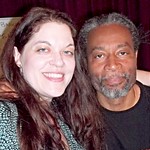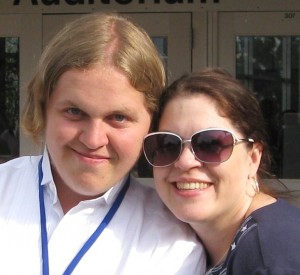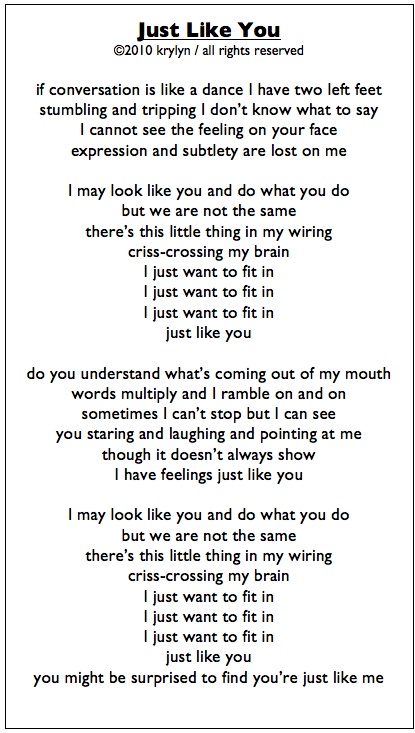Category Archives for Songwriting Therapy
What is a CircleSong
Imagine a room full of people with the same intention…to come together, express themselves creatively, work together in community, and have fun. This is what it is like during the process of Circle Singing.
The term CircleSong was coined by the innovative, improvisational Grammy Award-Winning singer Bobby McFerrin as a way to explain his process of community singing, a tradition of several indigenous cultures around the world. Singers stand in a circle with one person (aka the “conductor” and “composer”) in the middle who leads the singers in a song, introducing different motifs or musical phrases to each singing section.
The effect is a layering of sound, as I like to call it. Think of a finished piece of music and all the parts to it, including the rhythm, bass, chords, melody, harmony, etc. In CircleSongs, all these parts are accomplished with the voice, no instruments. And introduced one at a time. The composer lets the creativity flow, thinking of new musical parts to add as inspiration strikes. It is not planned. It is all spontaneous and improvised, sparked by the energy in the room.
There is something special that happens when you get people singing and making music together. Musicians call it the “groove” or the “pocket,” when that moment happens when everything seems to synch up and just be an effortless expression. Everyone is on the same page, so to speak, and feeling the music in the same rhythm.
Once this synching happens, when everyone is singing one of the musical phrases, the composer then sings a solo in the middle of the circle and/or invites others into the circle to sing solos. Think of the solo as the melody to the song, with all the other voices are singing the underlying arrangement of the song. The composer is supported by the arrangement and the other singers in this safe space, the middle of the circle, and once again draws on unplanned, spontaneous, improvisation as the inspiration.
I have been leading CircleSongs since days after I returned from New York and my training with CircleSong creator, Bobby McFerrin. I have seen the power of this process change people’s attitudes about themselves and about singing in general. I’ve gotten people from claiming they can’t sing to stepping in the middle of a circle of strangers and singing a solo. I’ve felt the energy shift from anxiety and nervousness to calm and energized. I’ve seen looks of terror on faces turn to smiles.
To say that the CircleSong process is inspiring is an understatement. It is a calling, a part of my soul, and an absolutely necessary part of my creative expression. Which is why I’m so excited to be bringing CircleSongs to my local community on a regular, monthly basis, starting January 9, 2013. I invite you to give CircleSongs a try.
For further information about CircleSongs and to listen to samples of CircleSongs I led while studying in New York, please visit http://www.krylyn.com/circlesongs. To register for an upcoming CircleSong group go to http://circlesongs.eventbrite.com.
Coming Full Circle: One Songwriter’s Journey to CircleSongs á la Bobby McFerrin
I wrote my first song at age 8 and by age 14 was composing fully arranged songs. Songwriting became my “drug of choice” as a teenager. I used songwriting to cope with growing up in a chaotic environment where neglect and abuse ran rampant. Songwriting was not only my form of escape from all the drama going on around me, but also a way for me to express some pretty deep thoughts and feelings.
Even though I came from a musically-inclined family, I didn’t feel much support from any of them as I came into my own as a young musician. But I did find support and inspiration from people who shared their talent and vulnerability in their own music.
In the 1980’s, I stumbled upon the most unique vocalist I’d ever heard – Bobby McFerrin – who used his voice (and body) as an instrument. His vocal ability left me in awe. Mind you, the 1980’s were a magical time for music discovery. MTV and VH1 were just starting out. I don’t remember exactly where I first heard Mr. McFerrin, but I do remember the first song I heard. Take a listen below.
After watching his performance, I was hooked. I began a journey of more creativity and improvisation in my own songwriting. I began singing non-sense type lyrics and just vocal sounds over musical phrases I’d created with my synthesizers and drum machine beats. Friends and family I shared these little experiments with either LOVED them or didn’t. There wasn’t much in between. But for me, the experience of improvisation was profound. There was a freedom in the creative process I hadn’t felt before, the idea that I could do anything with the sounds and that was okay. It didn’t have to be perfect.
This kind of experimentation opened up doors for me as I continued my songwriting journey. I began using non-traditional instruments in my arrangements (such as wooden spoons pounded on phone books) and continued to explore using my voice as an instrument. I also created a capella arrangements, using my voice for all parts of a song (bass, percussion, chords, etc.). I always seem to come back to the voice.

When I found Mr. McFerrin trained others in some of his improvisational singing techniques, I was on board. The only problem is that when I found out, it was just after he had led a workshop in New York at the Omega Institute in 2005. Year after year, I checked back with the institute, but no more classes were scheduled. Then one fateful day in January 2011, an email came into my inbox announcing the return of McFerrin’s CircleSong workshop. I signed up immediately and had an amazing experience studying with him and his team of faculty in late August-early September 2011. (That’s a picture of me and Bobby to the left, September 2, 2011, in New York).
It is with deep joy and awe (and Bobby’s blessing) that I bring the CircleSong experience to my local community in Phoenix, Arizona. For further information about CircleSongs and to listen to samples of CircleSongs I led while studying in New York, please visit http://www.krylyn.com/circlesongs. To register for an upcoming CircleSong group go to http://circlesongs.eventbrite.com.
Watch and listen to the first song I ever heard by Bobby McFerrin…
The Effects of a Silenced Voice
 How unresolved emotions and traumatic events affect our voices has been a topic of interest for me for a long time. When we are victims of abuse or neglect or witness to such events, our voices can be affected in many ways. We may learn that:
How unresolved emotions and traumatic events affect our voices has been a topic of interest for me for a long time. When we are victims of abuse or neglect or witness to such events, our voices can be affected in many ways. We may learn that:
- it is unsafe (for ourselves and/or others) to speak up about wrongdoings
- people don’t talk about bad things that happen in our family
- it is not acceptable to express feelings such as fear, anger, sadness, etc.
For children especially, the mixed messages that often accompany abusive and neglectful situations (in addition to the abuse and neglect itself) leave a long-lasting imprint. People experiencing childhood trauma can grow up to experience:
- Distrust of others
- Low self esteem
- Poor boundaries in relationships (either too clingy or too distant)
- Feelings of unworthiness or self hatred
- Self abusive behaviors, such as:
- Poor nutrition, exercise, and hygiene habits
- Not getting enough rest, relaxation, and sleep
- Addictions – alcohol, prescription medications, illegal drugs, sex, shopping/spending, workaholism, etc.
- Depression or anxiety
- Lower threshold for dealing with stress
- Physical complaints and illness
The good news is that there is power and healing that can come out of the darkest of situations. Finding a way to express ourselves, our emotions and thoughts, and talk about the unspeakable events of our past can be very therapeutic, not only in healing old wounds but also in repairing current and future relationships. For some, using creative ways of expression is extremely beneficial, such as writing, art, music, and dance for example. These creative means can help us by:
- Allowing the expression of painful feelings in a less threatening way than speaking about them
- Giving voice to something that has been silent for a long time
- Helping us see and express what we have been afraid to
- Providing tangible evidence and validation of our experience
I have found such healing through the process of songwriting. And I enjoy helping others do the same.
Whatever way you choose to find your voice again that has been silenced, know that your journey will be filled with ups and downs. Remember though to take frequent stock of where you have been and where you are now, and celebrate the successes you have had along the way.
Cheers to Finding Your Voice again!
And if you’d like to learn how to use music, sound, and songwriting for healing, please join me for my upcoming Songwriting Therapy 101 class. Learn more here.
Photo: shh © by Inubleachanimefan
Using Creativity to Practice Good Self Care
 What is your ONE THING? You know when you do it over and over because it puts a smile on your face, helps calm you down, connects you with your inner wisdom (or Spirit some might say), allows you to express yourself fully and without limitation, and is something you are so passionate about, you light up ever time you think about it, talk about it, and do it?
What is your ONE THING? You know when you do it over and over because it puts a smile on your face, helps calm you down, connects you with your inner wisdom (or Spirit some might say), allows you to express yourself fully and without limitation, and is something you are so passionate about, you light up ever time you think about it, talk about it, and do it?
For me, that THING is songwriting. Sure, I have lots of other interests and things that give me the same (or similar) benefits. But songwriting is my first true love and one that’s always there for me, no matter what.
While it took me a really long time to be able to express WHAT songwriting does for me, I’ve certainly enjoyed the benefits for a really long time. I realize that songwriting has been my own form of self care since I was a teenager.
Songwriting helps tap into feelings and thoughts that hide and get trapped in some deep, dark places. I sometimes write and don’t know what a song is about right away. But then once it unfolds, I realize it expresses exactly what I needed to say. I’m also able to express myself in safer ways with songs because I can use metaphors and poetic phrases instead of being very direct. I love the power of words to be subtle and strong at the same time.
You may (or may not) consider yourself a songwriter, but I bet there’s that ONE THING, a creative way you have to get to those deep feelings and thoughts. Think about it. Here’s some possibilities:
- Poetry
- Writing
- Journaling
- Dancing
- Songwriting
- Singing
- Playing a musical instrument
- Painting
- Sculpting
- Drawing
- Scrapbooking
- Pottery
- Crafting
- Sewing
- Graphic design
- Photography
- Cooking
- Baking
- Fashion
I challenge you to identify what creative activities you do that allow you to take good care of yourself by allowing you to express yourself without inhibition. Feel free to share your thoughts by leaving a comment below.
Photo: Colores © by Enzo Ferrante
How Music Helps Teach Expectations
Here is a wonderful teaching moment Bobby McFerrin used to illustrate how we are wired into certain expectations…using only his body and sound. Just another example of how music can be used to teach non-musical things. Enjoy!
Singing for Autism

Me and My Awesome Son!
When my sound engineer, John Mahoney of Ravenpheat Studios in Glendale, Arizona, contacted me regarding a project he was working on to shed light on tolerance and accepting people for who they are, I knew I had to be a part of it. Since my son’s diagnosis of Asperger’s Syndrome, I have wanted to write a song somehow outlining a part of our journey. And John’s project gave me the perfect opportunity. My song “Just Like You” is told from the perspective of someone diagnosed with Asperger’s Syndrome, and talks about the experiences of feeling different, being treated differently, and having difficulty reading other people’s emotions. I consulted my son as I was writing the song and he said it’s an accurate portrayal…phew!
We All Shine On is a volunteer CD project combining the talents of musicians, poets, singers, and songwriters from around the United States. Proceeds from the CD will benefit the following charities:
- Yoomee Adventures, teaches bully/teasing/acceptance awareness and presents books and music at no cost to schools, libraries and children’s hospitals.
- Just One Voice, Just One Voice is an organization dedicated to improving the lives of people in Kenya and other developing countries.
- The Trevor Project, The Trevor Project is the leading national organization focused on crisis and suicide prevention efforts among lesbian, gay, bisexual, transgender and questioning (LGBTQ) youth.
While the project is done, John is still looking for help with sales and distribution to allow the above charities to benefit as much as possible. So if you or someone you know could help with that part, please contact me and I’ll get you in touch with John.
But in the meantime, please enjoy listening (below) to “Just Like You,” my song about autism written as a tribute to my wonderful, talented, intelligent, creative, sometimes misunderstood, blessing of a son…

